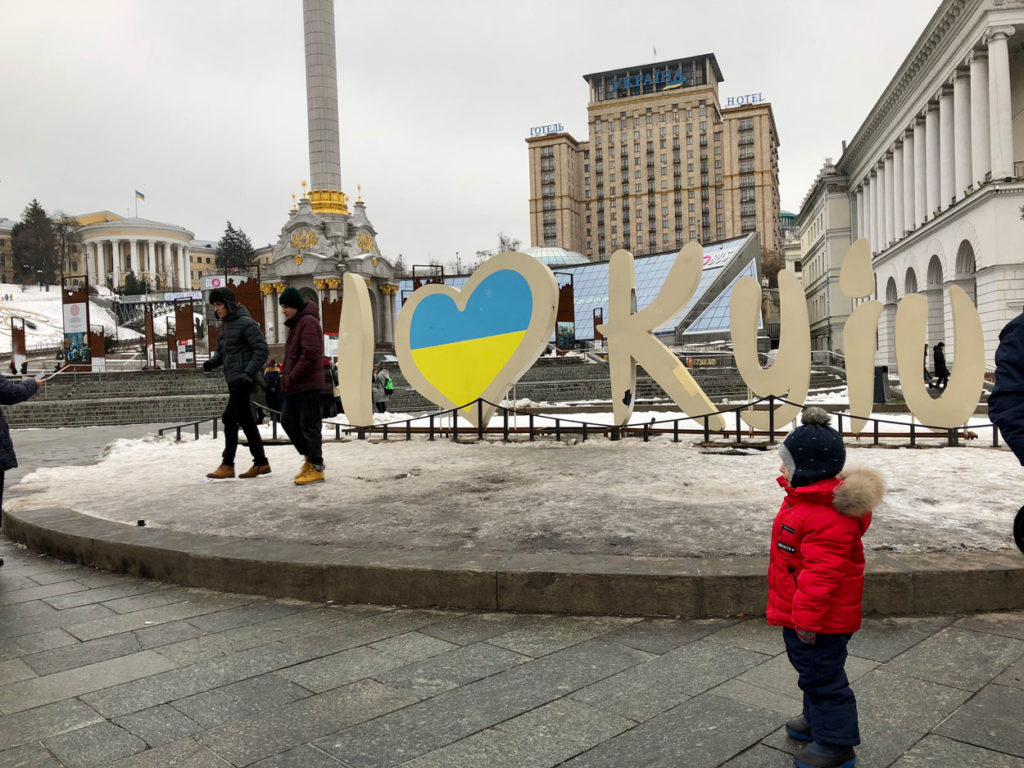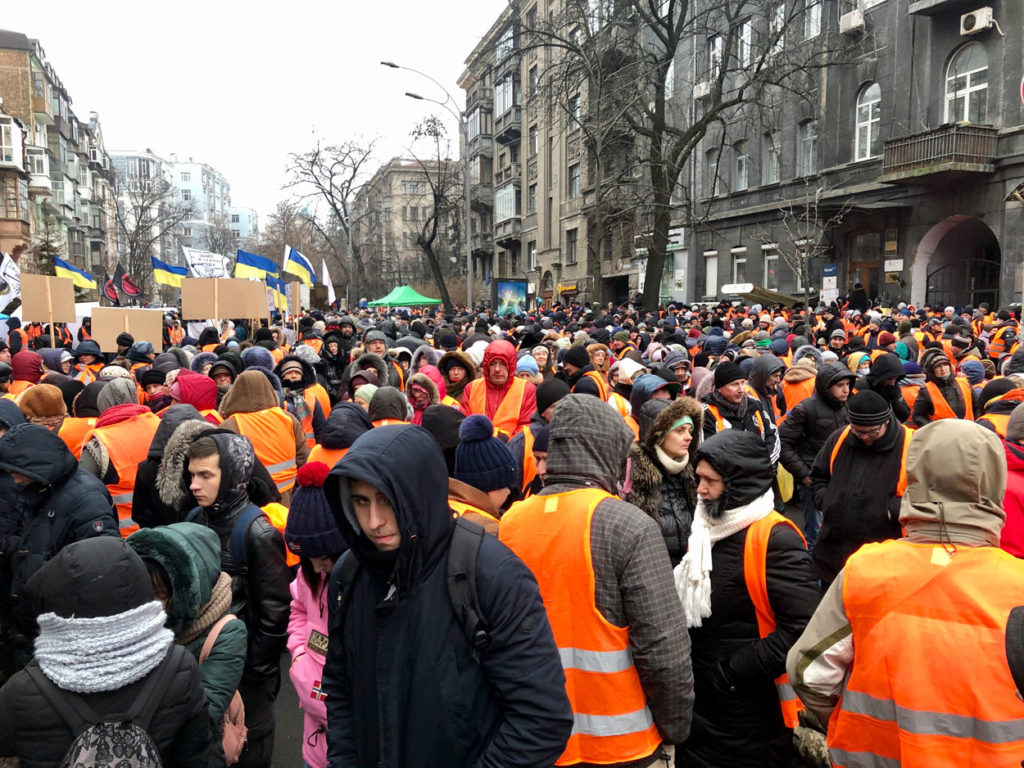KYIV, Ukraine—This is Ukraine’s sixth consecutive New Year at war.
In the frigid steppes of the country’s southeastern Donbas region, tens of
thousands of Ukrainian troops remain engaged in a defensive, limited conflict
against a Russian invasion force. Europe’s only ongoing land war has so far
killed more than 13,000 people and casualties still occur daily.
However, even as fighting continues in the Donbas, Kyiv and Moscow
recently found common ground on another, distant battlefield. On Dec. 30, the
two former Soviet allies agreed to a new five-year deal for Russian gas to
continue transiting through Ukrainian pipelines to the European Union.
The negotiations were a contentious nail-biter, coming down to the
final two days before the previous 10-year contract expired on Jan. 1. Both
Ukrainian and Russian leaders lauded the new deal as a win for their respective
countries.
“Europe knows, we won’t fail it in terms of
energy security,” Ukrainian President Volodymyr Zelenskyy wrote on Facebook.
“The signing of these documents indicates that it is possible to discuss and reach an understanding even on the most difficult issues … Russian gas transit via Ukraine will continue on terms acceptable for all sides,” Russia’s Prime Minister Dmitry Medvedev wrote on the Russian social media site VKontakte.

Underscoring what some experts saw as further evidence of a tepid
thaw between the two warring countries, Ukrainian and Russian forces conducted
a large-scale prisoner exchange on Dec. 29. In all, Ukrainian forces handed
over some 127 captured militants to the two Russian-backed separatist
territories in the Donbas. In turn, 76 Ukrainians were repatriated to
government-controlled territory.
To be sure, Dec. 29’s prisoner exchange was a breakthrough
achievement for Ukraine after nearly six years of war. So, too, was Dec. 30’s
gas transit contract agreement with Russia. Yet, many Ukrainian experts and
officials remain skeptical that a broad détente with Moscow is truly in the
works. The general consensus among Ukrainians is that the chances for peace
remain bleak in 2020.
“It depends on what you call peace. A general cease-fire in the
east—then yes. But peace as part of a peace treaty—unlikely,” Ivan Lishchyna,
deputy minister of justice of Ukraine, told The Daily Signal.
“In short—no, peace is not possible in 2020,” Lishchyna said.
Michael Bociurkiw, a former spokesman for the Organization for
Security and Cooperation in Europe, was similarly skeptical about the war
ending in 2020, yet he saw recent events such as the prisoner swap and the gas
deal as “major confidence-building measures which nudge the two sides toward
the ultimate goal of peace.”
“Although my expectations for a long-lasting and durable
cease-fire are extremely low, such agreements need to be viewed as a step
forward,” Bociurkiw told The Daily Signal.
Gas Wars
Russia is the top supplier of the European
Union’s natural gas imports, comprising roughly 40% of the market. Of that
amount, about 45% of Russia’s gas exports to the EU go through a network of
Ukrainian transit pipelines built by the Soviet Union in the 1970s and 1980s.
In what was roughly a $3 billion a year business
in Ukraine, revenue from transit Russian gas comprised
about 3% of the country’s gross domestic product under the recently-expired
10-year contract.
Russia’s economy is also heavily dependent on gas
exports. Gazprom’s sales reportedly comprise 5% of Russia’s $1.6 trillion
annual gross domestic product. Of that number, European customers account for
about 70% of Gazprom’s gas revenue, according to company data.
Since the breakup of the Soviet Union in 1991, Russia has often leveraged its power over Ukraine through the energy economy. Particularly, by cutting off gas supplies in winter.

Thus, Dec. 30’s contract renewal agreement eases concerns that Moscow might turn off the spigots this year. And—for the time being at least—it appears that Kyiv has secured the promise of sustained revenue from Russian gas transit fees for five more years. To boot, on Dec. 27, Russia’s national gas conglomerate Gazprom also paid an outstanding $2.9 billion arbitration penalty to Ukraine’s state-owned gas company, Naftogaz.
“The Russians had no choice but to accept our proposal on gas
transit,” said Alexander Khara, deputy chair of the Black Sea Institute of
Strategic Studies, a think tank. “To secure cash inflow and to avoid gas supply
disruptions to their European consumers, the Russians agreed on a compromise.”
Still, the new contract marks a sharp reduction in transit gas
revenue for Ukraine.
In 2019, Russia sent about 90 billion cubic meters of gas through
Ukrainian pipelines to the EU. However, Dec. 30’s new contract guarantees less
than half that amount—40 billion cubic meters of Russian gas per year—through
Ukrainian pipelines until the end of 2024. That flow will generate about $7.2
billion in revenue for Ukraine over five years, representing about half the
income rate of the previous contract, analysts say.
The Nord Stream 2 Effect
For Ukraine, the new five-year gas deal with Russia is somewhat of
a stopgap measure, softening the inevitably negative economic impact of
Russia’s controversial Nord Stream 2 pipeline, which is scheduled for
completion in 2020. Once online, the new pipeline will effectively double
Russia’s capacity to directly deliver gas to Europe.
“As to the signed agreement on gas transit, it’s more the result
of Russia’s current inability to make it alone without the Ukrainian gas
transit system than a sign of a possible, broad détente,” said Mykola Bielieskov, deputy director of the
Institute of World Policy, a Ukrainian think tank.
“The most important issue is still unresolved: What will Ukraine
do when Nord Stream 2 is completed and starts pumping gas and Russia no longer
needs Ukraine’s gas transit system?” Bielieskov said.
“This issue is just postponed until 2025.”
Nord Stream 2 parallels the existing Nord Stream pipeline’s path
from Russia under the Baltic Sea, making landfall near Greifswald, Germany.
Nord Stream—which went operational in 2011— is the longest undersea pipeline in
the world, capable of delivering 55 billion cubic meters of Russian gas
annually to Germany. That gas can then be forwarded on to other European
clients.
U.S. officials have opposed Nord Stream 2 because it increases
Europe’s dependence on Russian gas and bypasses
Ukrainian transit pipelines.
“The problem with Nord Stream 2 is that it is not an economic project. It was developed for only one reason: to create an alternative route for transporting Russian gas on the way to Europe that does not pass through Ukraine,” U.S. Ambassador to Germany Richard Grenell said last year.

Originally, Nord Stream 2 was slated for completion by the end of
2019. Yet, U.S. sanctions late last year targeted Gazprom’s construction
contractors. Work on Nord Stream 2 stopped on Dec. 20 when Allseas, a Swiss-based offshore pipeline and platform company,
withdrew from the Russian project.
Without Nord Stream 2 up and running, Russia still needed
Ukrainian transit pipelines to get its gas to Europe this winter. Thus, U.S.
sanctions effectively delayed Nord Stream 2’s completion just long enough to
force Russia’s hand in signing a new gas transit contract with Ukraine before
the end of 2019, when the previous contract expired.
“The driver of the gas deal was the U.S.’ sanctioning of Nord
Stream 2, which delayed Russia’s timeline for the completion of the pipeline
and thus forced Gazprom to continue to export gas through Ukraine,” Michael
Carpenter, a former senior Pentagon official who specialized on Russia and
Ukraine during the Obama administration, told The Daily Signal.
“I don’t think the gas deal will pave the way toward a resolution
of the conflict, though it’s certainly a positive development,” Carpenter said.
For its part, Gazprom says the Nord Stream 2 project is still
on track for completion in 2020. Moreover, Nord
Stream 2 is not the only economic headache for Kyiv tied to Russian gas. TurkStream,
another Gazprom pipeline under construction, also bypasses Ukraine, connecting
Russia with Turkey under the Black Sea.
TurkStream comprises two pipeline strings, each of which has the
capacity to deliver 15.75 billion cubic meters annually. According to
information on Gazprom’s website, the first string is meant to deliver gas to
Turkey, while the second string will directly deliver Russian gas to
southeastern Europe.
Russian President Vladimir Putin and Turkish
President Recep Erdogan are scheduled to celebrate the opening of TurkStream on Jan.
8.
TurkStream has reportedly already begun delivering Russian gas to
Bulgaria, a country that has traditionally gotten its Russian gas via a
pipeline that goes through Ukraine and Romania.
More Than Meets the Eye?
In September, Kyiv and Moscow exchanged 70 prisoners—35 from each
camp. Two planes decked out in their respective Ukrainian and Russian paint
jobs shuttled between Kyiv and Moscow to complete the deal. In contrast,
Sunday’s prisoner exchange took place at a military checkpoint near the
front-line town of Horlivka. Although it was a lower key affair with less press
coverage, Zelenskyy heralded the swap as “a great victory.”
“The most important thing is that people are
home,” Zelenskyy said Sunday, welcoming home the freed Ukrainians.
Zelenskyy swept into office in 2019 on a perceived mandate to end
the war. To that end, the Ukrainian leader—a former comedian with no previous
government experience—has made several bold peace overtures to Moscow to
jump-start peace talks.
Among those gambits, Zelenskyy has authorized the unilateral
withdrawal of Ukrainian forces from some front-line positions. He also agreed
in principle to hold elections in the Donbas—a longstanding Russian requirement
to sit down for peace talks.
Zelenskyy’s efforts to break the war’s stalemate have spurred weeks of peaceful protests across Ukraine and a
nationwide “anti-capitulation” movement. Polling shows that many
Ukrainians are reluctant to trust Russia. War
veterans, in particular, have been outspoken in their opposition to Zelenskyy’s
peace plans, demanding that he not hold elections in the Donbas until all
Russian troops have left the contested territory.
“I do not think that Zelenskyy’s current peace talks with Russia
have any chance of success,” said Volodymyr Mozghovyi, head of the Ukrainian
Youth Organization.
“Ukrainians need to defend their country,” Mozghovyi told The
Daily Signal. “Otherwise, Putin will celebrate victory in Kyiv—then in Warsaw.”
If elections are held before Ukraine has full control of the
Donbas, Zelenskyy’s critics contend, then Russia can influence the vote in
support of its preferred candidates, giving the Kremlin virtual voting rights
in Ukraine’s national legislature.
However, despite the domestic blowback, Zelenskyy
has pressed forward and scored some high-profile successes in pursuit of a
peace deal. Notably, the Ukrainian president sat down with Putin for peace talks in
Paris on Dec. 9.
Brokered by French and German leaders, the Paris talks symbolized
a recommitment by both Kyiv and Moscow to the Normandy Format, a peace
negotiation framework dating back to June 2014 that also comprises France and
Germany.
In the run-up to Paris, Ukraine’s outsized role in Washington’s
current impeachment drama had some Ukrainian
experts and officials worried that Zelenskyy may lose negotiating leverage
against Putin if it looked like American support was in jeopardy.
Yet, the general consensus among Ukrainians is that Zelenskyy held his own opposite Putin. While the Paris peace talks didn’t lead to a breakthrough, they also didn’t hurt Ukraine’s position, either, many Ukrainians believe.

In a joint communiqué following the Paris summit, the four
Normandy Format participants committed to both a full cease-fire and a prisoner
swap by year’s end. They also agreed on the need for elections in the Donbas—a
point that remains a fractious issue among Ukrainians opposed to Zelenskyy’s
peace efforts.
While Sunday’s prisoner exchange was certainly something to
celebrate, the New Year’s cease-fire never materialized—Russian shelling
wounded one Ukrainian soldier on Jan. 1. Consequently, a comprehensive peace
deal with Russia isn’t likely to happen anytime soon, many officials and
experts say.
“Putin still needs it to put pressure on Ukraine so he can achieve
his goal of controlling the country’s geopolitical orientation,” said
Carpenter, the former senior Pentagon official. “I don’t see any conditions
present that would cause the Kremlin to give up on this goal.”
Khara from Black Sea Institute of Strategic Studies shared a
similar prognosis regarding the likelihood of peace in 2020.
“The Russians believe that they have the upper hand over the West
in general, and Ukraine in particular,” Khara said.
War Season
In April 2014 Russia carried out a hybrid warfare invasion of the
Donbas. Caught off guard initially, Ukrainians soon rallied to their country’s
defense by launching a grassroots war effort. By that July, a ragtag coalition
of Ukrainian government troops and civilian militias had gained the upper hand
against Russia’s forces. Then, with its hybrid warfare plan in shambles, Russia
outright invaded eastern Ukraine with thousands of its own regular
troops.
Today the conflict is a limited, conventional war, mostly fought
from trenches. A cease-fire known as Minsk II went into effect in February
2015, locking the war along its current front lines.
Over the years, the war has waxed and waned in intensity amid a
succession of failed truces. Russia has dialed up and down the violence in the
Donbas as a way to coercively leverage its hard power advantage over Ukraine.
Consequently, Ukrainian experts and officials are generally skeptical that
Putin would voluntarily give up his single most powerful bargaining chip
against Kyiv without a clearly beneficial trade-off.
“Peace depends on many factors, but the main one is Russia’s desire to reach a peaceful solution,” said Iryna Vereshchuk, a Ukrainian member of parliament.

The U.S. and the EU levied economic sanctions on Russia after its
2014 invasions of Crimea and the Donbas. Vereshchuk believes Russia would
likely only accept a peace deal if it included relief from those Western
sanctions, or if Ukraine renounced its claim to Crimea.
“Ukraine will not be able to do this in 2020 or other years,”
Vereshchuk said about the possibility of abandoning Crimea. “[Western]
sanctions are the only way to force Russia to rethink its policy toward
Ukraine.”
Russia maintains de facto military and political control over the
two so-called separatist territories in eastern Ukraine. Ukrainian officials
say the combined Russian-separatist’s ranks of more than 30,000 militants
comprise several thousand Russian regulars who mainly serve in command and
control roles.
Despite reenergized peace talks, the pace of fighting in the
Donbas has not yet significantly relented. Ukrainian combat casualties maintain
a steady rate of about one death every three days, which has persisted for
years.
“Russia has no intention of backing down. Every day in the Donbas,
Ukrainian soldiers receive presents from their enemies on the other side of the
battlefield,” said Dmitry Dovzhenko, a Ukrainian veteran of the war in the
Donbas.
Impossible Peace?
Despite the steady violence, the war in the Donbas is no longer an
existential threat to the Ukrainian state or the country’s pro-Western
trajectory. Rather, the war is a persistent governor on Ukraine’s democratic
development, diverting political attention, money, and civil-society energy
away from anti-corruption reforms and economic development.
Bielieskov, of the Institute of
World Policy, predicts the war will likely remain at a “continued
stalemate” throughout 2020 because neither Ukraine nor Russia is facing an
economic crisis that would force its leaders into making unwanted concessions
to end the war.
“Russian leadership sees the current status quo in the Donbas as
bearable and continues to think it can just outwait Ukraine and have, in the
end, somebody in Kyiv who can do Moscow’s bidding,” Bielieskov said.
“On the other hand, Moscow is generally unable to compel Ukraine to implement the Minsk agreements as the Russian side sees fit,” he added, referring to the two cease-fire deals.

The war galvanized Ukrainian civil society, spurring a patriotic,
grassroots reform movement, which has sustained the 2014 revolution’s
pro-democracy momentum. The war has also irrevocably tarnished the image of
Russia in Ukrainians’ eyes for generations to come. Today, most Ukrainians are
skeptical of reconciliation as long as Ukrainian territory remains under Russian
control.
“I do not see [peace] as a possibility until the very unlikely
scenario of Russia leaving the Donbas … and the even more unlikely scenario of
it abandoning Crimea,” Lishchyna, the deputy minister of justice of Ukraine,
said.
Source material can be found at this site.









